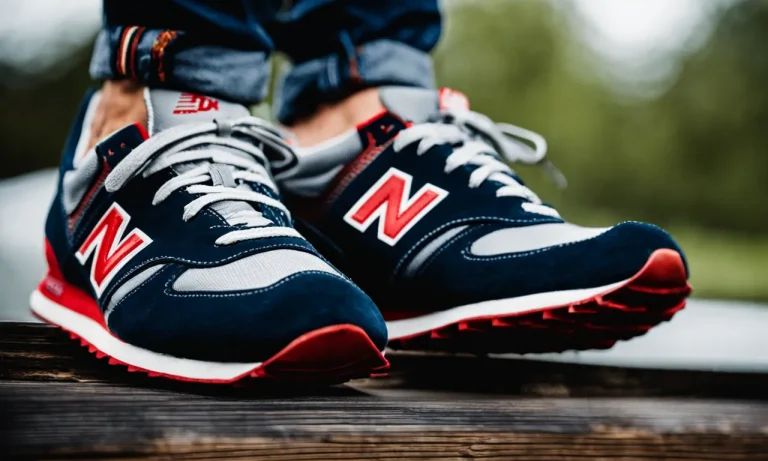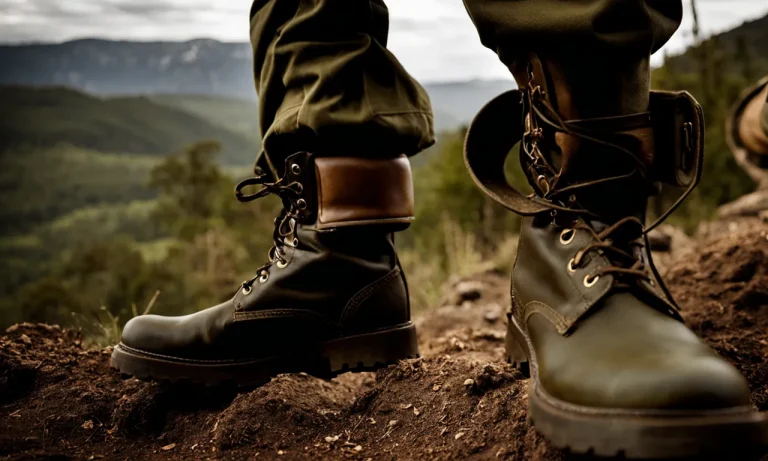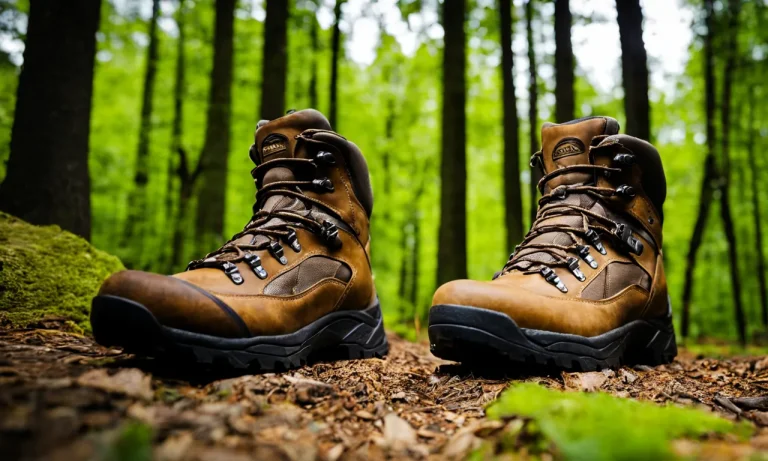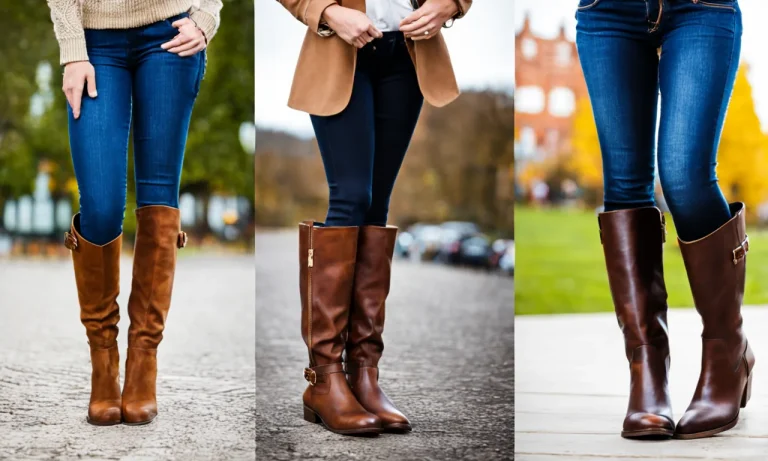Boots and shoes – they cover your feet, but does that make them the same thing? This seemingly simple question has sparked many a heated debate. If you’ve ever found yourself wondering if a boot can truly be considered a type of shoe, you’re not alone.
In this comprehensive guide, we’ll examine the murky lines between boots and shoes to finally provide a definitive answer.
If you’re short on time, here’s the quick answer: Technically, a boot is considered a type of shoe due to sharing the main function of protecting and covering the foot. However, boots tend to be designed for more heavy-duty use, with differences in material, height, traction, and style versus regular close-toed shoes.
The Shared Functions and Purposes of Shoes and Boots
When it comes to footwear, both shoes and boots serve essential functions and purposes. While they may have some differences in style and design, they share common features that make them indispensable in our daily lives.
Protecting the Feet
One of the primary functions of both shoes and boots is to protect our feet from potential hazards. Whether it’s sharp objects on the ground, extreme weather conditions, or workplace hazards, both types of footwear act as a barrier between our feet and the outside world.
Shoes, with their lighter and more flexible construction, are ideal for everyday activities, such as walking or running. They provide adequate protection while allowing for ease of movement and comfort.
On the other hand, boots, with their higher ankle support and sturdier construction, are better suited for more demanding activities like hiking or working in rugged environments.
Providing Traction
Another shared function of both shoes and boots is to provide traction. The soles of these footwear options are designed to grip the ground, reducing the risk of slips and falls. Whether it’s a rainy day or a slippery surface, the traction provided by shoes and boots can prevent accidents and ensure stability.
Allowing Mobility
Both shoes and boots allow for mobility and freedom of movement. They are designed to fit the shape of our feet and provide support during various activities. Whether you’re walking, running, or engaging in sports, the right footwear can enhance your performance and prevent discomfort or injuries.
Shoes, with their lighter and more flexible construction, allow for a greater range of motion, making them suitable for everyday activities. Boots, with their added stability and ankle support, are better for activities that require more robust foot and ankle protection.
Meeting Style Needs
While functionality is crucial, shoes and boots also serve style needs. They come in a wide variety of designs, colors, and materials, allowing individuals to express themselves and match their footwear to their personal style.
Whether it’s a sleek pair of dress shoes for a formal occasion or trendy boots for a casual outing, both shoes and boots can be fashionable accessories that complement our outfits and make a statement.
Key Differences in Design and Use Cases
Height
One of the key differences between boots and shoes lies in their height. Boots typically extend above the ankle, providing more coverage and support to the lower leg. This added height offers benefits such as increased stability and protection in rough terrains or hazardous conditions.
Shoes, on the other hand, are generally lower-cut and do not provide the same level of coverage as boots.
Materials
The materials used in the construction of boots and shoes also differ. Boots are commonly made from thicker and more durable materials such as leather or synthetic materials that can withstand harsh conditions. This makes them suitable for activities such as hiking or working in rugged environments.
Shoes, on the other hand, often use lighter and more flexible materials that prioritize comfort and breathability.
Traction and Tread
When it comes to traction and tread, boots tend to have more aggressive patterns on their outsoles. These patterns are designed to provide better grip and traction on uneven or slippery surfaces. This makes boots ideal for activities like hiking, mountaineering, or working in slippery conditions.
Shoes, on the other hand, often have a smoother outsole with less pronounced tread patterns, as they are typically designed for everyday use in urban environments.
Intended Conditions and Durability
Boots are often designed to withstand more extreme conditions and offer greater durability. They are built to handle rough terrains, harsh weather conditions, and heavy-duty work. Shoes, on the other hand, are usually designed for regular daily use and may not be as durable or suitable for demanding environments.
However, it’s worth noting that there are specialized types of shoes, such as hiking or work shoes, that offer increased durability and protection.
For more information on the differences between boots and shoes, you can visit Outdoor Gear Lab, a reputable source that provides in-depth reviews and comparisons of various types of footwear.
A Brief History of Boots vs. Shoes
Throughout history, footwear has played a significant role in human civilization. From protecting our feet to making fashion statements, shoes and boots have evolved over time. Let’s take a closer look at the relationship between boots and shoes and how they have developed throughout history.
Early Beginnings
Boots and shoes have been worn by humans for thousands of years. The earliest known footwear dates back to around 10,000 years ago and was made from animal hides. These early shoes were simple in design, offering basic protection for the feet.
As civilizations advanced, so did the design of footwear. In ancient Egypt, for example, people wore sandals made from reeds or papyrus. In ancient Rome, both boots and shoes were popular, with boots being worn by soldiers and shoes by the general population.
Rise of Fashion Footwear
As societies became more fashion-conscious, the distinction between boots and shoes began to emerge. Boots were typically associated with practicality and durability, while shoes were seen as more fashionable and delicate.
During the Renaissance period in Europe, boots became a symbol of power and authority. High leather boots were worn by knights and noblemen, while women often wore heeled shoes adorned with intricate designs.
In the 19th century, the Industrial Revolution brought significant changes to the footwear industry. Mass production techniques allowed for the creation of a wide variety of shoes and boots, making them more accessible to the general population.
This era saw the rise of iconic shoe styles such as the Oxford and the Chelsea boot.
Modern Distinctions Emerge
In modern times, the distinction between boots and shoes has become more defined. Boots are typically characterized by their higher length, extending above the ankle or even up to the knee. They provide additional coverage and support, making them suitable for outdoor activities, harsh weather conditions, and certain occupations.
Shoes, on the other hand, are generally lower in height and offer more flexibility and freedom of movement. They come in various styles, including sneakers, loafers, and heels, catering to different fashion preferences and occasions.
While the line between boots and shoes has become clearer, there are still overlapping styles that blur the distinction. For example, ankle boots have become increasingly popular and can be considered a hybrid between boots and shoes.
As fashion trends continue to evolve, so too will the relationship between boots and shoes. Whether you prefer the practicality of boots or the versatility of shoes, both play an essential role in our daily lives and will continue to do so in the future.
Boots as a Shoe Subcategory in Retail and Manufacturing
Boots, a popular footwear choice for many, hold a unique place in the world of shoes. While they share similarities with other types of footwear, such as sneakers and sandals, boots also possess distinct characteristics that set them apart.
Understanding the relationship between boots and shoes is crucial for both retailers and manufacturers in order to effectively categorize and market their products.
Department Store Categories
In most department stores, boots are considered a subcategory of shoes. They are typically grouped together with other shoe styles such as dress shoes, athletic shoes, and casual shoes. This categorization allows customers to easily navigate through the store and find the specific type of footwear they are looking for.
Whether it’s a pair of trendy ankle boots or sturdy work boots, customers can expect to find them in the shoe section of a department store.
Shoe Brand Approaches
When it comes to shoe brands, their approach to boots may vary. Some brands choose to have separate lines specifically dedicated to boots, while others incorporate boots into their overall shoe collections. This decision often depends on the brand’s target market and their overall brand image.
For example, a brand that focuses on outdoor and adventure footwear may have a dedicated line of hiking boots, while a fashion-forward brand may include various boot styles within their seasonal collections.
Industry Classification Systems
Within the footwear industry, there are various classification systems that help standardize the categorization of boots and shoes. One such system is the United Nations Standard Products and Services Code (UNSPSC), which provides a coding structure for different types of products, including footwear.
This system allows manufacturers and retailers to classify boots and shoes based on their specific features, materials, and intended use.
Another commonly used classification system is the Harmonized System (HS) codes, which are used for international trade. These codes help identify the type of footwear being imported or exported, ensuring that customs authorities and businesses have a clear understanding of the product being traded.
It’s important for retailers and manufacturers to be aware of these industry classification systems in order to accurately label and market their boots and shoes. This ensures that customers can easily find the footwear they desire, while also facilitating international trade and compliance with import/export regulations.
Cultural Associations and Colloquial Comparisons
When examining the relationship between boots and shoes, it is important to consider the cultural associations and colloquial comparisons that have developed over time. These associations and comparisons can vary based on factors such as formality, gender, and symbolism.
Formal vs. Casual
One of the key distinctions between boots and shoes lies in their formality. While shoes are often associated with formal attire, such as dress shoes worn with suits or gowns, boots are generally seen as more casual.
This is not to say that there are no formal boots or casual shoes, but the overall perception remains that shoes lean towards formal occasions, while boots are more suited for casual or outdoor settings.
For example, a pair of elegant high-heeled shoes might be chosen for a fancy night out, while a sturdy pair of leather boots would be ideal for a hike in the mountains.
Masculine vs. Feminine
Another aspect to consider is the gender connotations associated with boots and shoes. Traditionally, boots have often been associated with masculinity, while shoes have been seen as more feminine. This can be attributed to historical factors, such as the use of boots in military or rugged outdoor activities.
However, it is important to note that these gender associations are not set in stone and can vary across different cultures and time periods.
For instance, in some cultures, high-heeled boots are considered fashionable for women, challenging the traditional notion that boots are solely masculine.
Occupational and Symbolic Meanings
Boots and shoes can also carry occupational and symbolic meanings. Certain types of boots, such as steel-toed boots, are often associated with specific professions like construction or logging, where safety and protection are paramount.
On the other hand, shoes can symbolize elegance, sophistication, and even social status.
Furthermore, boots have often been used symbolically to represent rebellion or counterculture movements. Think of the iconic image of a biker wearing leather boots, or the association of combat boots with punk or gothic subcultures.
It is interesting to note that these associations and meanings can evolve and change over time, influenced by fashion trends, societal shifts, and cultural influences.
When considering whether a boot is a shoe, it becomes clear that while there are similarities between the two, they also have distinct characteristics that set them apart. Understanding the cultural associations and colloquial comparisons surrounding boots and shoes can help us appreciate the diverse ways in which footwear is perceived and used in different contexts.
Conclusion
So in summary – is a boot a type of shoe? Technically yes, but with some caveats. While boots share the primary function of protecting feet with other closed-toe footwear, key differences in height, traction, durability, and style set them apart from standard shoe designs.
Context also matters; work boots are viewed differently than fashion boots. So feel free to confidently call boots shoes, but recognize they occupy their own distinct category too.






